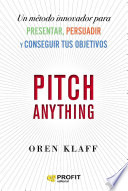

The STRONG method is a framework that stands for Setting the Frame, Telling the Story, Revealing the Intrigue, Offering the Prize, Nailing the Hookpoint, and Getting a Decision. This approach emphasizes the importance of controlling the context of your pitch, engaging your audience through storytelling, and creating urgency around your offer. By setting the frame, you define the parameters of the conversation, which helps to steer the audience's perception. The story you tell should resonate with the audience's emotions, making it relatable and compelling. Revealing intrigue keeps the audience engaged and curious, while offering a prize gives them something to strive for. The hookpoint is critical for ensuring that your audience is not just passive listeners but active participants in the decision-making process. Ultimately, getting a decision is about closing the deal effectively, ensuring that both parties feel satisfied with the outcome.
Continue readingFrame control is the ability to dictate the perspective from which your pitch is viewed. In any interaction, there are multiple frames at play, and the dominant one is often the one that determines the outcome. By establishing your frame first, you can influence how your audience perceives your message. This involves understanding the different types of frames—such as power frames, time frames, and outcome frames—and using them strategically. For instance, a power frame positions you as the authority in the conversation, while a time frame creates urgency. Mastering frame control allows you to navigate complex negotiations and steer discussions toward favorable outcomes.
Continue readingStorytelling is a powerful tool in pitching because it connects with the audience on an emotional level. Humans are wired to respond to stories; they help us make sense of the world and relate to others. In 'Pitch Anything,' the author emphasizes the need to craft a narrative that not only presents facts but also evokes emotions. A well-told story can captivate an audience, making them more receptive to your message. It also helps to illustrate your points in a relatable way, allowing the audience to see themselves in the narrative. The author provides techniques for effective storytelling, including the use of conflict and resolution, which can heighten engagement and retention.
Continue readingCreating a sense of urgency and intrigue is essential for keeping your audience engaged and motivated to act. This can be achieved through various tactics, such as highlighting the scarcity of your offer or the potential consequences of inaction. By framing your pitch in a way that emphasizes what the audience stands to gain or lose, you can increase their investment in the outcome. Intrigue is also about presenting information in a way that piques curiosity—this could involve revealing only parts of your offer or posing thought-provoking questions. The combination of urgency and intrigue helps to maintain attention and drives the audience toward a decision.
Continue readingUnderstanding the psychology behind decision-making is crucial for effective pitching. The author delves into the cognitive biases and emotional factors that influence how people make choices. For example, people often rely on heuristics—mental shortcuts that simplify decision-making. By recognizing these biases, you can tailor your pitch to align with the audience's thought processes. This might involve framing your offer in a way that appeals to their desires or fears, thus making it more compelling. Additionally, the book discusses the importance of building rapport and trust, as these elements play a significant role in the decision-making process.
Continue readingNon-verbal communication is a critical aspect of pitching that is often overlooked. Body language, eye contact, and tone of voice can significantly impact how your message is received. The author stresses the importance of being aware of your own non-verbal cues and those of your audience. For instance, open body language can convey confidence and approachability, while closed body language may signal discomfort or disinterest. By mastering non-verbal communication, you can enhance your presence and make a stronger impression during your pitch. This is particularly important in face-to-face interactions, where visual cues can reinforce or undermine your spoken words.
Continue readingClosing the deal is the final and often the most challenging part of the pitching process. The author provides strategies for effectively guiding your audience to a decision. This involves not only presenting a compelling case but also addressing any objections or concerns they may have. It's essential to create an environment where the audience feels comfortable making a commitment. Techniques such as the assumptive close, where you act as if the decision has already been made, can be effective. Additionally, ensuring that both parties feel satisfied with the outcome is crucial for maintaining long-term relationships and potential future opportunities.
Continue readingThe reading time for Pitch anything depends on the reader's pace. However, this concise book summary covers the 7 key ideas from Pitch anything, allowing you to quickly understand the main concepts, insights, and practical applications in around 19 minutes.
Pitch anything is definitely worth reading. The book covers essential topics including The STRONG Method, The Importance of Frame Control, Storytelling as a Tool, providing practical insights and actionable advice. Whether you read the full book or our concise summary, Pitch anything delivers valuable knowledge that can help you improve your understanding and apply these concepts in your personal or professional life.
Pitch anything was written by Oren Klaff.
If you enjoyed Pitch anything by Oren Klaff and want to explore similar topics or deepen your understanding, we highly recommend these related book summaries:
These books cover related themes, complementary concepts, and will help you build upon the knowledge gained from Pitch anything. Each of these summaries provides concise insights that can further enhance your understanding and practical application of the ideas presented in Pitch anything.